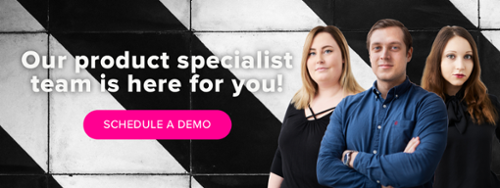7 ways to improve your digital asset management
Have you recently taken the plunge and invested in a brand new DAM system? Or are you in the process of evaluating and weighing up the options? Great! Your life is about to get a whole lot easier. At least in theory.
A digital asset management system is a lot like a filing cabinet. If you stick to a solid organization system, it works like a charm. If you don’t—well, things start to go pear-shaped. So before even setting up your DAM, it’s essential you consider how to structure it and what you want to use it for. Not only will it save you time down the line, but it’ll help others find exactly what they’re looking for too.

Follow these tips and best practices, and you’ll be well on your way to creating a watertight system with a solid file structure.
Firstly, less is more
While it might seem like an admirable goal to put all your company's assets in one place, if you have a lot of company content, that might actually be undesirable. In our experience, instead of making everything available to everyone, it's better to make the right content available to the right people.One way to do with is with permissions and user roles. Another way is to use themed image or document collections as well as groups of files, allowing you to distribute only the relevant content to each individual, team or department.
Get savvy with keywords
When organizing your DAM, it’s essential you make it as easy to navigate as possible. Being savvy with keywords is one way of doing just that. Some DAM systems create keywords based on a file’s location. So be mindful of the keywords you use. If, for example, you put a file called “Beach Images” in a folder named “Vacation Photography,” the file will pop up whenever you search for “vacation,” “beach,” or “images.” Just one of the many ways of structuring your DAM to make it work for you.The Pickit platform enables you to add both tags and descriptions to your images, so you can always make sure you're personalizing your content and making sure you're using any relevant search terms and keywords particular to your organization.
Use templates
Templates often take just hours to create, but they can save you days and days by eliminating the need to keep creating new presentations, docs and files over and over again. Get smart with your file storage and distribute PowerPoint and Word templates that can easily be extended, enhanced and personalized by your colleagues. By making company-approved templates available together with your visuals, it's easier for people to adapt their own material without committing brand crimes while they're at it.Talk to the people who'll be using it
Before launching into full DAM organization mode, consult your team. How are they going to use the system? Are there any company guidelines for organizing shared files? If so, take inspiration from these to reduce the risk of confusion for other team members. Meeting with others is also the perfect opportunity to update user settings and access options, saving you time later on.And don't forget to ask yourself
You spend a great deal of your working day supporting the efforts of other departments. So let us suggest you spend a little more time thinking about your own needs! Yes, introducing a DAM system is about providing a strong organizational structure everyone can follow, but the marketing team will benefit more than most. If you persuade management to invest in a DAM platform, you’ll be helping the whole company to help you work better.At most companies, the task of sourcing, and monitoring the use of, visual content across the entire company falls onto your overworked marketing team. This can be a huge administrative pain in the butt. You waste copious amounts of time searching for images for other people’s projects, and because you’re regular elite marketing professionals and not The Avengers, you can’t possibly do it all, no matter how good you are. Manually quality-checking every image in every presentation and piece of marketing material your colleagues use is just not an option. Not to mention worrying about the copyright issues of people stealing stuff from the internet.

Don’t forget training
Once you’ve got a beautifully organized DAM, run a workshop with your whole team to ensure everybody understands the system. And remember to keep people informed about any tweaks you make along the way. Train, train, and train again. Sending instructions on how to navigate the DAM is useful, but nothing beats hands-on training to ensure your users all feel confident.
Lastly, ask questions!
And don't forget, if you have more questions about how to make the most of an existing DAM system or you're interested in seeing how Pickit could work for your company, click the button to schedule a quick demo call and we'll be happy to answer any questions or get you set up with a free trial.
